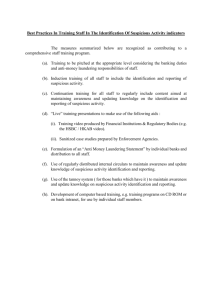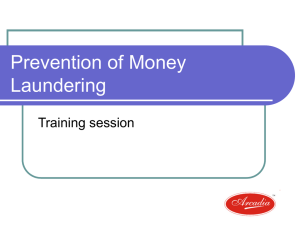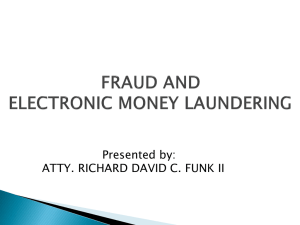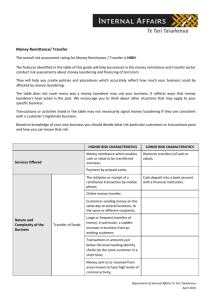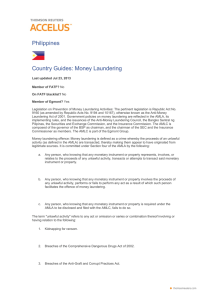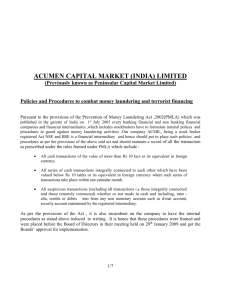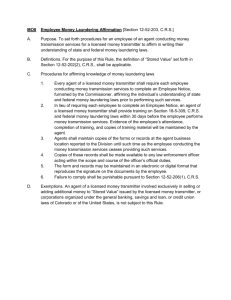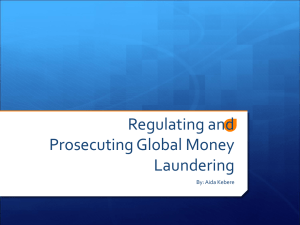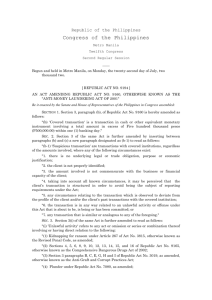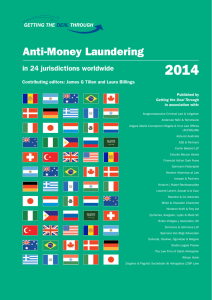Primer on the Anti-Money Laundering Act of 2001
advertisement
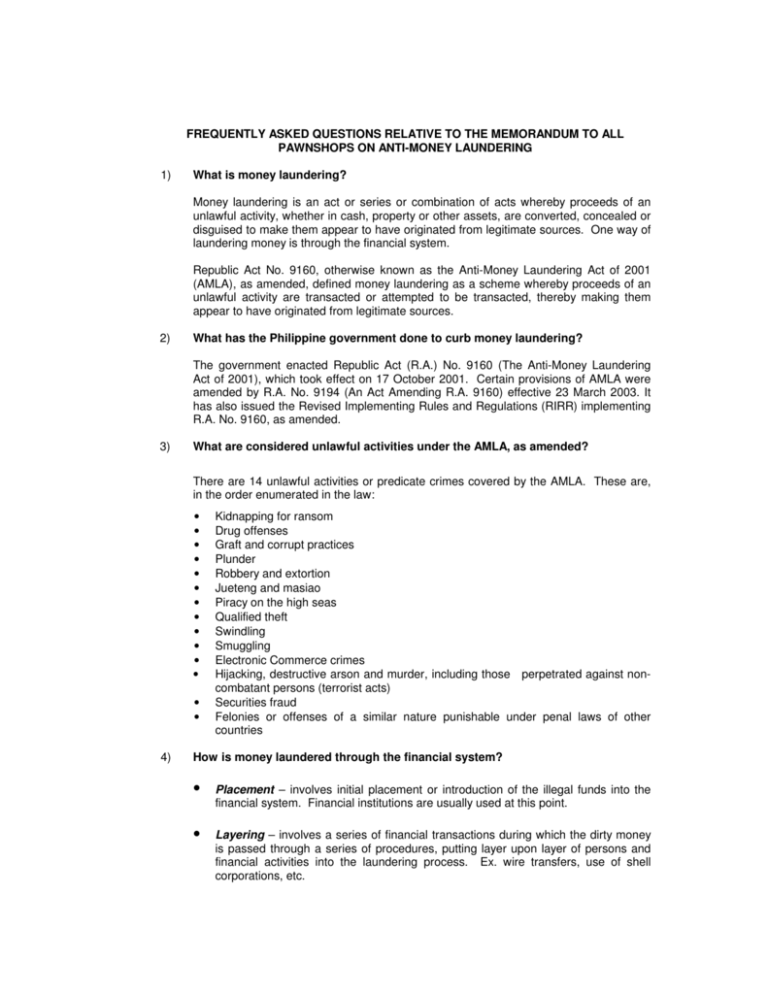
FREQUENTLY ASKED QUESTIONS RELATIVE TO THE MEMORANDUM TO ALL PAWNSHOPS ON ANTI-MONEY LAUNDERING 1) What is money laundering? Money laundering is an act or series or combination of acts whereby proceeds of an unlawful activity, whether in cash, property or other assets, are converted, concealed or disguised to make them appear to have originated from legitimate sources. One way of laundering money is through the financial system. Republic Act No. 9160, otherwise known as the Anti-Money Laundering Act of 2001 (AMLA), as amended, defined money laundering as a scheme whereby proceeds of an unlawful activity are transacted or attempted to be transacted, thereby making them appear to have originated from legitimate sources. 2) What has the Philippine government done to curb money laundering? The government enacted Republic Act (R.A.) No. 9160 (The Anti-Money Laundering Act of 2001), which took effect on 17 October 2001. Certain provisions of AMLA were amended by R.A. No. 9194 (An Act Amending R.A. 9160) effective 23 March 2003. It has also issued the Revised Implementing Rules and Regulations (RIRR) implementing R.A. No. 9160, as amended. 3) What are considered unlawful activities under the AMLA, as amended? There are 14 unlawful activities or predicate crimes covered by the AMLA. These are, in the order enumerated in the law: • • • • • • • • • • • • • • 4) Kidnapping for ransom Drug offenses Graft and corrupt practices Plunder Robbery and extortion Jueteng and masiao Piracy on the high seas Qualified theft Swindling Smuggling Electronic Commerce crimes Hijacking, destructive arson and murder, including those perpetrated against noncombatant persons (terrorist acts) Securities fraud Felonies or offenses of a similar nature punishable under penal laws of other countries How is money laundered through the financial system? Placement – involves initial placement or introduction of the illegal funds into the financial system. Financial institutions are usually used at this point. Layering – involves a series of financial transactions during which the dirty money is passed through a series of procedures, putting layer upon layer of persons and financial activities into the laundering process. Ex. wire transfers, use of shell corporations, etc. Page 2 of 2 Integration – the money is once again made available to the criminal with the occupational and geographic origin obscured or concealed. The laundered funds are now integrated back into the legitimate economy through the purchase of properties, businesses and other investments. 5) Why is Money Laundering a problem? Money laundering allows criminals to preserve and enjoy the proceeds of their crimes, thus providing them with the incentives and the means to continue their illegal activities. At the same time, it provides them the opportunity to appear in public like legitimate entrepreneurs. Organized crime, through money laundering, is known to have the capacity to destabilize governments and undermine their financial systems. It is thus a threat to national security. 6) 7) What are the salient features of the law? • It criminalizes money laundering, meaning it makes money laundering a crime, and provides penalties for its commission, including hefty fines and imprisonment. • It states clearly the determination of the government to prevent the Philippines from becoming a haven for money laundering, while ensuring to preserve the integrity and confidentiality of good bank accounts. • It creates an Anti-Money Laundering Council (AMLC) that is tasked to oversee the implementation of the law and to act as a financial intelligence unit to receive and analyze covered and suspicious transaction reports. • It establishes the rules and the administration process for the prevention, detection and prosecution of money laundering activities. • It relaxes the bank deposit secrecy laws authorizing the AMLC and the Bangko Sentral ng Pilipinas access to deposit and investment accounts in specific circumstances. • It requires covered institutions to report covered and suspicious transactions and to cooperate with the government in prosecuting offenders. It also requires them to know their customers and to safely keep all records of their transactions. • It carries provisions to protect innocent parties by providing penalties for causing the disclosure to the public of confidential information contained in the covered and suspicious transactions. • It establishes procedures for international cooperation and assistance in the apprehension and prosecution of money laundering suspects. What is the Anti-Money Laundering Council (AMLC)? What are its powers? The AMLC is the Philippines’ financial intelligence unit, which is tasked to implement the AMLA. It is composed of the Governor of the Bangko Sentral ng Pilipinas (BSP) as Chairman & the Commissioner of the Insurance Commission (IC) and the Chairman of the Securities and Exchange Commission (SEC) as members. The AMLC is authorized to: • Require and receive covered or suspicious transaction reports from covered institutions. Page 3 of 3 8) 9) • Issue orders to determine the true identity of the owner of any monetary instrument or property that is the subject of a covered or suspicious transaction report, and to request the assistance of a foreign country if the Council believes it is necessary. • Institute civil forfeiture and all other remedial proceedings through the Office of the Solicitor General. • Cause the filing of complaints with the Department of Justice or the Ombudsman for the prosecution of money laundering offenses. • Investigate suspicious transactions, covered transactions deemed suspicious, money laundering activities and other violations of the AMLA. • Secure the order of the Court of Appeals to freeze any monetary instrument or property alleged to be the proceeds of unlawful activity. • Implement such measures as may be necessary and justified to counteract money laundering. • Receive and take action on any request from foreign countries for assistance in their own anti-money laundering operations. • Develop educational programs to make the public aware of the pernicious effects of money laundering and how they can participate in bringing the offenders to the fold of the law. • Enlist the assistance of any branch of government for the prevention, detection and investigation of money laundering offenses and the prosecution of offenders. In this connection, the AMLC can require intelligence agencies of the government to divulge any information that will facilitate the work of the Council in going after money launderers. • Impose administrative sanctions on those who violate the law, and the rules, regulations, orders and resolutions issued in connection with the enforcement of the law. What are the covered institutions? • Banks, offshore banking units, quasi-banks, trust entities, non-stock savings and loan associations, pawnshops, and all other institutions, including their subsidiaries and affiliates supervised and/or regulated by the Bangko Sentral ng Pilipinas (BSP) • Insurance companies, holding companies and all other institutions supervised or regulated by the Insurance Commission (IC) • Securities dealers, brokers, pre-need companies, foreign exchange corporations, investment houses, trading advisers, as well as other entities supervised or regulated by the Securities and Exchange Commission (SEC) What are the Customer Identification Requirements – KYC (Know Your Customer Rule)? Covered institutions shall: • Establish and record the true identity of their clients based on official documents. Page 4 of 4 10) • In case of individual clients, maintain a system of verifying the true identity of their clients. • In case of corporate clients, require a system verifying their legal existence and organizational structure, as well as the authority and identification of all persons purporting to act in their behalf. • Establish appropriate systems and methods based on internationally compliant standards and adequate internal controls for verifying and recording the true and full identify of their customers. What are the Record-Keeping Requirements? All covered institutions shall: 11) • Maintain and safely store all records of all their transactions for 5 years from the transaction dates; • Ensure that said records/files contain the full and true identity of the owners or holders of the accounts involved in the covered transactions and all other identification documents; • Undertake the necessary adequate measures to ensure the confidentiality of such files; • Prepare and maintain documentation, in accordance with client identification requirements, on their customer accounts, relationships and transactions such that any account, relationship or transaction can be so reconstructed as to enable the AMLC and/or the courts to establish an audit trail for money laundering; • Maintain and safely store all records of existing and new accounts and of new transactions for 5 years from October 17, 2001 or from the dates of the accounts or transactions, whichever is later; • Anent closed accounts, preserve and safely store the records on customer identification, account files and business correspondence for at least 5 years from the dates they were closed; • If a money laundering case based on any record kept by the covered institution has been filed in court, retain said files until it is confirmed that the case has been finally resolved or terminated by the court; and • Retain records as originals in such forms as are admissible in court What are covered transactions? Transaction in cash or other equivalent monetary instruments involving a total amount in excess of P = 500,000.00 within one (1) business day. 12) What are suspicious transactions? Transactions, regardless of the amount involved, where the following circumstances exist: a. there is no underlying legal or trade obligation, purpose or economic justification; Page 5 of 5 13) b. the client is not properly identified; c. the amount involved is not commensurate with the business or financial capacity of the client; d. taking into account all known circumstances, it may be perceived that the client’s transaction is structured in order to avoid being the subject of reporting requirements under the Act; e. any circumstance relating to the transaction which is observed to deviate from the profile of the client and/or the client’s past transactions with the covered institution; f. the transaction is in any way related to an unlawful activity or offense under this Act that is about to be, is being or has been committed; or g. any transaction that is similar or analogous to the foregoing. What are the reporting requirements? Covered institutions shall report to the AMLC all covered transactions and suspicious transactions within five working days from occurrence thereof, unless the Supervision Authority (the Bangko Sentral ng Pilipinas, the Securities and Exchange Commission, or the Insurance Commission) prescribes a longer period not exceeding ten (10) working days. Should a transaction be determined to be both a covered transaction and a suspicious transaction, it shall be reported as suspicious transaction. 14) How is reporting done? The reports on covered and/or suspicious transactions shall be accomplished in the prescribed formats and submitted within five (5) business days from occurrence of the transactions in a secured manner to the AMLC in electronic form, either via diskettes, leased lines, or through internet facilities. The corresponding hard copy for suspicious th transactions shall be sent to AMLC at the 5 Floor EDPC Building, Bangko Sentral ng Pilipinas Complex, Manila, Philippines. All pawnshops should coordinate with the AMLC thru tel. nos. 523-4421, 521-5662 or 302-3979 on reporting requirements, procedures and deadlines. 15) Are there sanctions for failure to report covered or suspicious transactions and non-compliance with R.A. 9160, as amended? Sanctions/penalties shall be imposed on pawnshops that will fail to comply with the provisions of R.A. 9160, as amended. 16) What are the sanctions for failure to report covered or suspicious transactions? Any person, required to report covered and suspicious transactions failed to do so will be subjected to penalty of 6 months to 4 years imprisonment or a fine of not less than P = 100,000.00 but not more than P = 500,000.00, or both. 17) Are there confidentiality restrictions on the reporting of covered transaction and/or suspicious transaction? When reporting covered transactions or suspicious transactions to the AMLC, covered institutions and their officers and employees, are prohibited from communicating, directly or indirectly, in any manner or by any means, to any person, entity, the media, Page 6 of 6 the fact that a covered or suspicious transaction report was made, the contents thereof, or any other information in relation thereto. Neither may such reporting be published or aired in any manner or form by the mass media, electronic mail, or other similar devices. In case of violation thereof, the concerned officer, and employee, of the covered institution, or media shall be held criminally liable. 18) What are the other offenses punishable under the AMLA, as amended? a. Failure to keep records is committed by any responsible official or employee of a covered institution who fails to maintain and safely store all records of transactions for 5 years from the dates the transactions were made or when the accounts were closed. The penalty is 6 months to 1 year imprisonment or P = 100,000.00 but not more than P = 500,000.00, or both. b. a fine of not less than Malicious reporting is committed by any person who, with malice or in bad faith, reports or files a completely unwarranted or false information regarding a money laundering transaction against any person. The penalty is 6 months to 4 years imprisonment and a fine of not less than P = 100,000.00 but not more than P = 500,000.00. The offender is not entitled to the benefits of the Probation Law. c. Breach of Confidentiality. For this offense, the penalty is 3 to 8 years imprisonment and a fine of not less than P = 500,000.00 but not more than P = 1 million. In case the prohibited information is reported by media, the responsible reporter, writer, president, publisher, manager, and editor-in-chief are held criminally liable. d. Administrative offenses. The AMLC, after due investigation, can impose fines from P = 100,000.00 to P = 500,000.00 on officers and employees of covered institutions or any person who violates the provisions of the AMLA, as amended, the Implementing Rules and Regulations, and orders and resolutions issued pursuant thereto. Page 7 of 7
